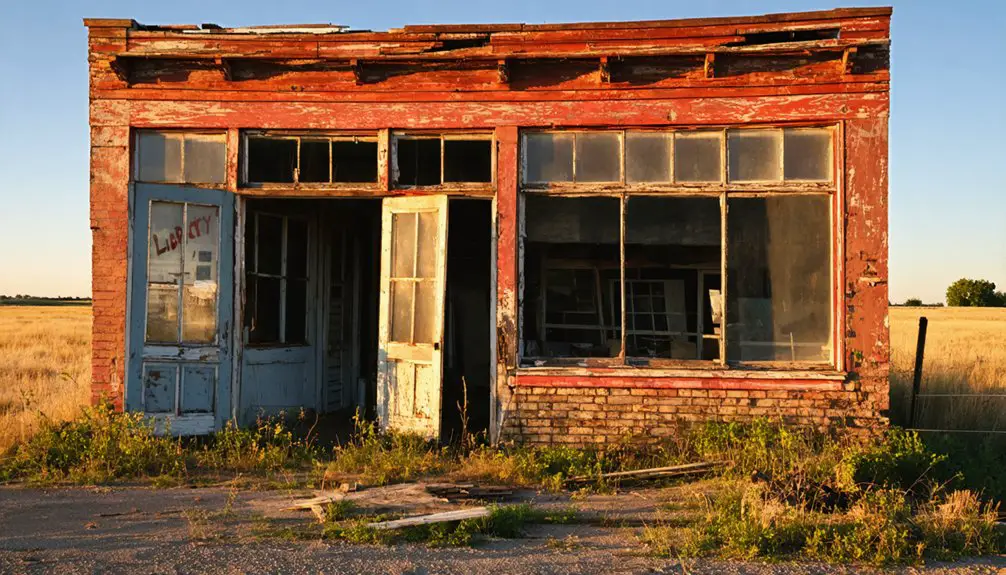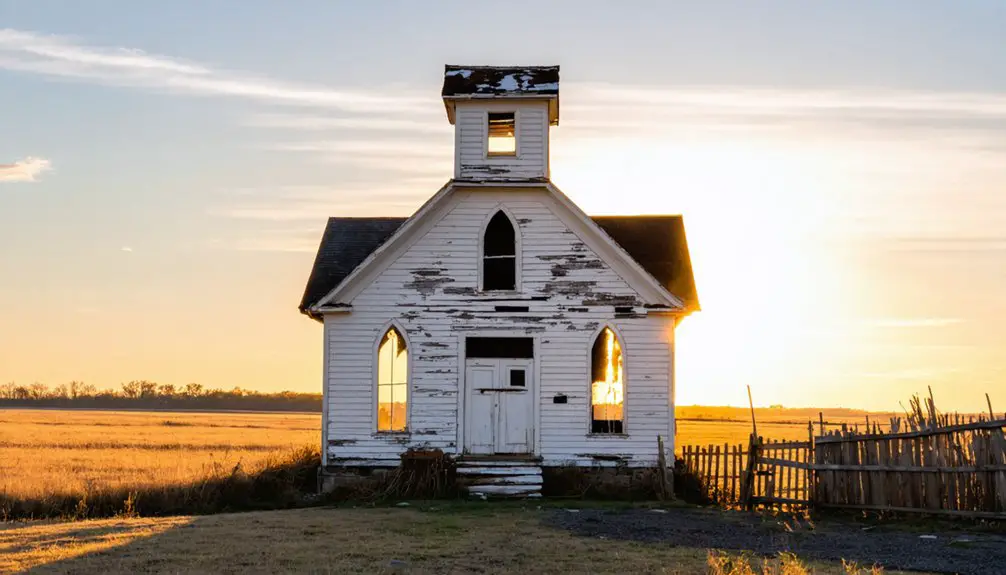You’ll find Liberty, Oklahoma among twenty-eight all-Black settlements established in Oklahoma Territory between 1865-1920. Starting with Wallace W. Baird’s 40-acre claim in 1912, this rural community thrived through farming and strong community bonds. Located at the intersection of Okmulgee and Tulsa counties, Liberty’s population dropped from 220 in 2010 to 153 by 2020. Today, preservation efforts protect this ghost town’s powerful legacy of African American self-determination and resilience.
Key Takeaways
- Liberty is an all-Black ghost town in Oklahoma established after the Civil War, located at the intersection of Okmulgee and Tulsa counties.
- The town experienced significant population decline, dropping from 220 residents in 2010 to 153 by 2020, illustrating its ghost town status.
- Wallace W. Baird was the first documented settler, claiming 40 acres in 1912 as part of Oklahoma’s historical Black settlement movement.
- Economic challenges and over-reliance on agriculture led to Liberty’s decline, with 86% of residents commuting elsewhere for work by 2000.
- Preservation efforts maintain Liberty’s historical significance as one of Oklahoma’s twenty-eight all-Black towns established between 1865 and 1920.
The Birth of an All-Black Settlement
While the end of the Civil War brought emancipation, many African Americans faced continued oppression in the South, leading them to seek new opportunities in Oklahoma’s Indian Territory.
You’ll find their settlement motivations were rooted in a powerful desire for self-determination and economic independence. Many of these settlers were formerly enslaved by the Five Civilized Tribes, and they chose to establish communities near fellow African Americans they knew from their past.
When the Land Run of 1889 opened additional territories, you’d see Black settlers responding to promotions from leaders like E.P. McCabe, who painted Oklahoma as a promised land. The Langston City Herald newspaper helped spread McCabe’s vision of Oklahoma settlement throughout the South.
Their community resilience showed in their commitment to building self-sustaining towns where they could govern themselves, own land, and create safe spaces free from the racial violence that plagued the South. Between 1865 and 1920, Oklahoma Territory became home to twenty-eight all-Black towns, establishing a remarkable network of independent Black communities.
Early Settlers and Community Formation
As the twentieth century dawned in Oklahoma Territory, Liberty’s first documented settler, Wallace W. Baird, staked his claim to 40 acres of farmland in 1912.
Like many settlers driven by the promise of land ownership, you’d have found Baird and others arriving by horseback, wagon, and train, enthusiastic to establish their agricultural practices in this new frontier.
The development of Liberty reflected a common pattern seen in Oklahoma’s history, where communities often faced economic booms and busts that shaped their destinies.
Unlike the 1873 settlement of Liberty, Washington which was established after a gold rush discovery in Swauk Creek, Liberty, Oklahoma began as a farming community.
Geographic Features and Layout
Located at the intersection of Okmulgee and Tulsa counties, Liberty occupies a distinctive position in eastern Oklahoma’s landscape at 673 feet above sea level.
The town exemplifies ordered liberty through its balanced approach to land use, allowing residents freedom in property development while maintaining basic rural zoning standards.
You’ll find the town’s geographic diversity characterized by gently rolling plains and low hills, spread across 6.14 square miles of entirely rural land.
Based on detailed mapping from Here Today, Liberty stands among dozens of documented ghost towns scattered throughout Oklahoma’s eastern region.
Liberty’s rural infrastructure reflects its dispersed nature, with three key features:
- Direct access to U.S. Route 75 along the town’s western border
- Scattered homesteads and farmland instead of a traditional grid layout
- Secondary unpaved roads connecting to neighboring communities
The town’s layout emphasizes open spaces rather than concentrated development, with minimal public buildings and no commercial districts.
This arrangement has preserved Liberty’s character as a quintessential Oklahoma ghost town, where you’ll experience authentic rural solitude.
Daily Life in Liberty’s Peak Years
During Liberty’s peak years in the early 20th century, daily life revolved around a mix of industrial work and agricultural pursuits. Much like the town of Slick, Oklahoma, the population surged dramatically when oil was discovered. Oil companies established company-named settlements throughout the region, mirroring the pattern seen in many Oklahoma towns.
You’d find yourself sharing the streets with oil workers, farmers, and merchants, each contributing to the town’s dynamic economy. Social gatherings centered around the local church, school, and community halls, where you’d join your neighbors for dances and celebrations tied to harvest seasons and holidays.
Economic fluctuations affected everyone’s routines, as oil industry booms and busts shaped employment opportunities. You might’ve supplemented your income with small-scale farming or seasonal work.
The railroad’s presence kept Liberty connected to larger markets, while the wide main street accommodated horse teams hauling goods. Entertainment options included theater shows and local festivities, though these activities often depended on the town’s current prosperity.
Economic Challenges and Population Decline
While Liberty’s early years showed promise, the town’s over-reliance on agriculture ultimately sealed its fate. Like many of Oklahoma’s ghost town boomtowns, Liberty failed to sustain its early economic momentum.
You’ll find that by 2000, a staggering 86% of residents were commuting elsewhere for work, signaling deep economic stagnation. The population exodus became crystal clear when numbers plummeted from 220 in 2010 to just 153 by 2020 – a devastating 30.5% decline. Many homes sit vacant with a median value $60,000, similar to nearby Gracemont.
The town’s downfall can be traced to three critical factors:
Liberty’s decline stemmed from three key weaknesses: limited economic scope, failed development, and stronger regional competitors.
- Lack of economic diversification beyond farming
- Absence of industrial or commercial development to create local jobs
- Growing attraction of nearby economic centers like Tulsa and Glenpool
With only 24.9 inhabitants per square mile by 2020, Liberty transformed from a self-sustaining community into fundamentally a bedroom town, stripped of its economic independence.
Transportation Routes and Regional Impact
As transportation networks evolved across Oklahoma, Liberty’s fate became inextricably linked to its isolation from major rail and highway routes.
The town’s economic isolation intensified when railroads, once essential lifelines for small communities, bypassed the area. You’ll find that this transportation evolution proved devastating – while neighboring towns flourished with new highway connections, Liberty remained tethered to outdated local roads.
The Arkansas River’s proximity, which initially influenced settlement, couldn’t compensate for Liberty’s disconnection from modern infrastructure.
As Oklahoma’s transport system shifted from rail dominance to automobile highways, towns lacking these significant links faced inevitable decline. Liberty’s position south of Bixby, once strategically valuable, became a liability when metropolitan transport routes expanded elsewhere, accelerating its transformation into a ghost town.
Historical Significance in Oklahoma

Liberty’s historical significance among Oklahoma ghost towns stems from its distinctive pattern of gradual decline rather than dramatic collapse.
Unlike towns that vanished due to environmental disasters or economic crashes, Liberty’s story reflects a more common narrative in Oklahoma’s cultural heritage.
You’ll find that Liberty’s endurance, despite its small population, offers valuable insights into rural Oklahoma’s evolution:
- It’s preserved the authenticity of late 19th-century settlement patterns, without the disruption of major industrial booms.
- The town’s position across county lines has created unique historical landmarks in local governance.
- Its sustained existence, though diminished, contrasts with Oklahoma’s 2,000 completely abandoned ghost towns.
This persistence makes Liberty a living symbol of the challenges and resilience of rural communities in post-statehood Oklahoma.
Preservation Efforts and Remaining Structures
Through coordinated preservation initiatives, the remnants of Liberty and similar Oklahoma ghost towns have gained increased protection and documentation in recent years.
You’ll find that preservation strategies now involve multiple stakeholders, including Preservation Oklahoma (POK), which maintains a Most Endangered Historic Places list to mobilize support for threatened sites.
The structural assessment of Liberty reveals a pattern common to Oklahoma ghost towns – deteriorating buildings that face ongoing challenges from both natural erosion and human interference.
While some structures remain partially intact, many have decayed considerably.
You can support preservation efforts through POK’s public nomination process, which enables community involvement in identifying priorities.
Though listing doesn’t guarantee funding, it substantially increases public awareness and institutional backing for protecting these important historical sites.
Notable Residents and Their Stories

When you look at Liberty’s early settlers, you’ll find a determined group of African Americans who established essential community institutions like churches and schools while working primarily as farmers and skilled tradespeople in the 1890s.
Local leaders, including ministers and educators, strengthened the town’s social fabric through their advocacy for education, temperance, and self-sufficiency in the face of external pressures and limited resources.
Though specific names haven’t survived in historical records, the legacy of Liberty’s residents lives on through their pioneering spirit in establishing one of Oklahoma’s all-black towns during the post-Reconstruction era.
Early Settlers’ Daily Life
Among the earliest pioneers who shaped Liberty’s history, Wallace W. Baird established a 40-acre farm in 1912, introducing sustainable farming techniques that would influence the region’s agricultural development.
You’d find settlers like Baird facing daily challenges while carving out their existence in this frontier town.
Life for Liberty’s early settlers centered around three essential activities:
- Working the land through subsistence farming and managing livestock
- Defending claims against opportunistic claim jumpers
- Building community bonds through social gatherings at churches and schools
You’d witness families supporting one another, sharing resources, and relying on neighborly assistance for survival.
Without nearby railroads or highways, settlers mastered self-sufficiency, producing their own food and crafting necessary items while maintaining vigilant watch over their hard-won homesteads.
Community Leaders’ Lasting Impact
Liberty’s most influential leaders shaped the town’s character through their unwavering commitment to local autonomy and community development. Floyd Myers exemplified grassroots activism by hosting governance meetings in his home and staunchly opposing annexation attempts by larger cities.
The Harrison family, particularly A.W. and his son Floyd, alongside C.E. Duffner, established vital business partnerships that strengthened the town’s economic foundation.
These leaders’ impact extended beyond business interests, as they fostered community governance through strategic resistance to outside control. Their homes became centers for civic engagement, while family alliances, like the Harrison-Duffner connection, created resilient social networks.
Their dedication to protecting Liberty’s independence, especially in law enforcement jurisdiction disputes, established lasting precedents for small-town autonomy in Oklahoma.
Family Legacies Through Generations
Through interwoven family ties and enduring legacies, the bedrock of Liberty’s social fabric emerged from pioneering families like the Harrisons and Duffners. Their family resilience shaped the town’s development through mercantile enterprises, agricultural operations, and informal governance meetings in family homes.
Three pillars of generational stewardship defined Liberty’s family legacies:
- Maintaining local traditions and social cohesiveness despite population shifts
- Preserving landmarks and cultural heritage through continued residence
- Passing down oral histories and folklore that shaped the town’s identity
You’ll find their influence woven throughout Liberty’s story, from Floyd Harrison’s business ventures to the families who’ve remained as guardians of local history.
Even as the town transformed, these families adapted while protecting Liberty’s heritage through economic changes and demographic shifts.
Legacy in Modern Oklahoma
You’ll find historical markers today that commemorate Liberty’s role as one of Oklahoma’s all-black towns, preserving the memory of this significant settlement for future generations.
The town’s story continues to shape discussions about African American resilience and community-building during the post-Reconstruction era, particularly through educational programs and heritage tourism initiatives.
Local historians and cultural organizations work to maintain Liberty’s legacy through documentation projects and public awareness campaigns, ensuring that this ghost town’s impact on Oklahoma’s diverse cultural landscape isn’t forgotten.
Historical Markers Today
Modern visitors to Oklahoma can explore the state’s rich heritage through an extensive network of historical markers, administered by the Oklahoma Historical Society’s Historical Marker Program. These markers preserve stories of historical significance while serving as anchors for cultural remembrance across the state’s changing landscape.
When you’re exploring Oklahoma’s ghost towns and historical sites, you’ll discover markers that:
- Connect you directly to the state’s complex past, from Native American settlements to oil boom towns.
- Provide context for vanished communities and their roles in Oklahoma’s development.
- Support local economies through heritage tourism while maintaining links to regional identity.
Today’s markers aren’t just static monuments – they’re active participants in educational programs and community events, helping you understand how past events shaped modern Oklahoma’s character.
Community Identity Preservation
Historical markers tell only part of Liberty’s story – the deeper preservation of its identity continues through active community engagement and cultural memory initiatives.
You’ll find Liberty’s legacy living on through oral histories passed down by former residents and their descendants, while local historical societies work diligently to archive photographs, letters, and artifacts that capture the town’s unique African American heritage.
Digital platforms and social media groups now connect those interested in Liberty’s past, sharing stories and organizing preservation efforts.
Through museum exhibits and educational programs, you’re able to explore Liberty’s role in Oklahoma’s settlement patterns and economic development.
Community associations formed by descendants maintain cultural heritage through commemorative events and storytelling, ensuring that Liberty’s significance in Oklahoma’s history isn’t forgotten.
Frequently Asked Questions
Were There Any Natural Disasters That Contributed to Liberty’s Decline?
You won’t find evidence of natural calamities causing Liberty’s downfall. Historical records point to economic factors like railroad changes and urbanization as the main culprits behind its decline.
What Happened to the Liberty School District After the Town Declined?
Through student migration and school consolidation, you’ll find Liberty School District survived, adapted, and thrived, becoming known as “Liberty Mounds” while continuing to serve rural communities across Okmulgee and Tulsa counties.
Did Liberty Have Any Churches or Religious Gatherings During Its Existence?
You can’t definitively confirm Liberty’s church history or religious significance due to limited records, though like other Oklahoma ghost towns, it likely hosted informal religious gatherings among early settlers.
What Indigenous Tribes Originally Inhabited the Land Where Liberty Was Established?
You’ll find the Shawnee Nation was most prominent in Liberty’s area, with earlier presence of Mississippian descendants like the Caddo and Osage. The Wyandot, Delaware, and Cherokee later shared this cultural heritage.
Were There Any Local Festivals or Annual Celebrations Unique to Liberty?
Among 50+ all-black Oklahoma towns, you’ll find no documented unique festivals specific to Liberty. While local traditions likely included church gatherings and cultural celebrations, historical records don’t show any distinct annual events.
References
- https://www.youtube.com/watch?v=5d-wHDTIbb0
- https://www.okhistory.org/publications/enc/entry?entry=GH002
- https://kids.kiddle.co/List_of_ghost_towns_in_Oklahoma
- https://bixbyhistoricalsociety.com/explore/area-history/liberty-becomes-incorporated/
- https://en.wikipedia.org/wiki/Liberty
- https://www.justiceforgreenwood.org/black-settlement-in-oklahoma/
- https://www.okhistory.org/publications/enc/entry?entry=AL009
- https://www.thecommunitylight.org/oklahoma-black-townships
- https://travelnoire.com/what-happened-to-the-all-black-towns-in-oklahoma
- https://humanities.utulsa.edu/oklahoma-home-historically-black-towns-u-s-state/



